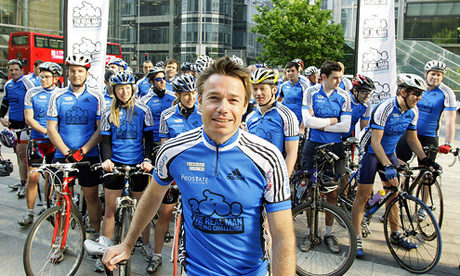
Hey guys, let's talk about prostate cancer. Bit of a downer? So it's not a favourite topic of male conversation, but prostate cancer is the most common form of cancer among men and few people know much about the disease.
In a bid to get men talking about it, the Prostate Cancer Charity has organised the Real Man Cycling Challenge, a huge cycling event that will see Mark Lawrenson, Adrian Chiles and Graeme Le Saux on their bikes. It will take place around London's Docklands on September 14. And, because I felt I needed a bit of practice before launching myself on the 34km road course, I booked myself a coaching session with Andy Cook, of British Cycling, at a prestigious cycling venue in west London.
Hillingdon racetrack is at the end of a somewhat unsavoury light-industrial estate that specialises in furniture and hi-fi warehouses. The track, at just over a mile, looks like a random scrawl of the north circular that skirts nondescript shrubs.
I'd brought along my bike, a determinedly non-competitive Raleigh 21-gear hybrid, painted a fetching shade of green. Andy didn't seem too impressed, so to show I was willing I peeled off my shirt and squeezed my stomach into a Real Man cycling shirt.
"First problem," says Andy, "is your saddle." I like to tip forward a bit, I said. Makes me feel like I'm going places. He shakes his head. "That way you'll get neck and shoulder pain. Forwards, you'll get shoulder or neck strain; back, and you'll get numb nuts." What's my position like, I ask? "You look like you're about to drive into a paddling pool," he says.
Finally abandoning my own bike, I am introduced to a whippet-thin Pinnacle Sentinel 1.0 racer that has the aerodynamics of a smartly-constructed paper dart. "Try a few laps on that," Andy suggests. Fine, I say, picking up speed as the first bend approaches. "Your cadence should be between 70 and 100 a minute." Cadence? "Rotations. How many times the pedals go round. Lance Armstrong keeps a constant 90-plus." I started counting, but got lost around 40.
Next comes the fitness burn. "To get ready for a 34k run, you need to build up your stamina so you're burning through glycogen, not just fat," counsels Andy. How much have I burned off so far? He gave me a look. "Not much," he says.
At that moment, a bluish blur in the distance solidifies into ex-Chelsea footballer Graeme Le Saux, who is haring round the track at a decent lick.
I was waiting for him the second time. Straining to catch up, I asked how long he had been cycling. "Since I was eight or nine," he fires back. "And I'm really sad that kids can't go out on their own [now]. My six-year-old was stopped by a guy who said he shouldn't be cycling on the road. What right has he got?"
Graeme starts to pull away, but I put on one last burst. "We should all get on our bikes, and use cycling as a family activity," he shouts. "I love it, but I do more off-road stuff, especially in Majorca. And I tend to go out with a group." Then, with a flick of his gears, he's off.
The good thing about cycling is that just about anyone can get on a bike. For a beginner, it's less technically demanding than darts, dominoes or the egg and spoon race. But how can I improve the way I cycle? Andy tells me that British Cycling has started a new scheme, Everyday Cycling, which seeks to establish virtual communities of cyclists who can then get together and commit to a practice regime more realistic than most cycling clubs. The main thing, according to Andy, is not to hammer yourself doing rapid bursts. "That way you'll burn up muscle tone and not much else," he said. "You need to build, not just burn."
"You are the engine," he says. "You need to put in about three hours a week, with people on your level. Then when you ride with a pack, you'll pick up tips from the other riders."
My pace eased as I caught sight of the finish line. "Slowing down?" quips Andy. Well, that's the end - isn't it time for tea and biscuits? "You're in training for a 34k event," he grins. "You need to start building up your stamina. Do another 10 laps."
What is prostate cancer?
The prostate is about the size of a walnut. Its main function is to produce and prolong the lifespan of seminal fluid. At present, doctors can't screen for it, nor can they distinguish between aggressive and non-aggressive prostate cancers. The Prostate Cancer Charity aims to raise £1m through the Real Man Cycling Challenge.
Because it is so hard to detect, prostate cancer killed 10,000 British males in 2005, making it the second highest killer after lung cancer. By contrast, 74 men died from testicular cancer.
The disease is more common among sixtysomethings, although younger men can get it Symptoms include excessive, painful or difficult urination. Risk factors include race (African-Caribbean men are three times more likely to develop prostate cancer) and diet, particularly animal fats and red meat.
For more information see prostate-cancer.org.uk
The Real Man Cycling Challenge
This is the first closed-road corporate cycling challenge. It aims to do for prostate cancer (and men) what high-profile events like Moonwalk do to promote breast cancer.
The first event of its kind, 2,000 cyclists - individually or in teams of up to four - will take to the streets, following a route that starts and ends at the Excel Centre, London Docklands.
The money raised will go towards funding high-quality research and providing a prostate cancer helpline staffed by specialist nurses. £1m could fund ten major research projects, or keep the helpline going for three years.
Real Man Cycling Challenge, Sunday 14 September. realmancyclingchallenge.com
British Cycling's everyday cycling initiative: everydaycycling.com

